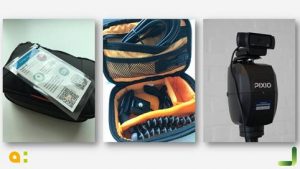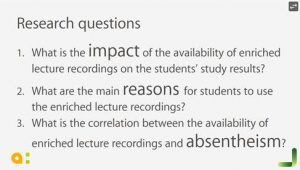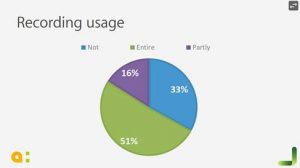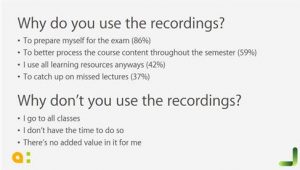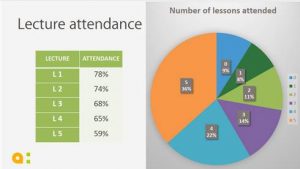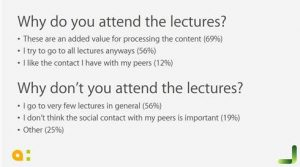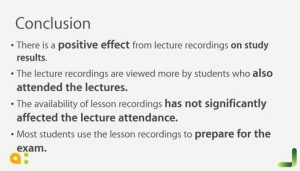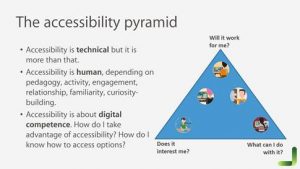The Digital Education team recently attended the 2019 Panopto EMEA Conference in Euston Square. Morning coffees quaffed and croissants consumed, the conference commenced with the opening keynote delivered by Eric Burns, Panopto founder and CEO.
Opening keynote – Eric Burns
Eric welcomed the delegates and began with a demonstration of how far the platform had advanced in the past decade, comparing the first iteration of the Panopto Silverlight player with the modern equivalent.
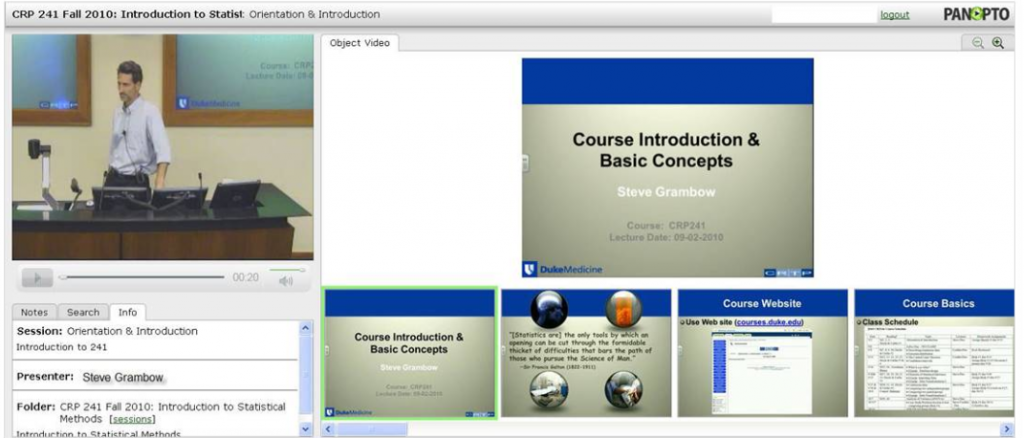
The keynote centered on the technological and cultural changes that have impacted Panopto. The talk was subdivided into the following topics: The Shift from hardware to software, the cultural normalisation of video in academia, the rise of multi streaming, the consumerisation of technology and the death of client software.
The Shift from hardware to software
The rapid increases in technological advancement and corresponding increase in affordability of hardware required for effective lecture capture has resulted in the majority of innovation arising from software, rather than hardware, in recent years. Eric highlighted the introduction of HD video cameras and the affordability of digital recorders, giving the example of a MAgewell USB capture card which cost $25,000 ten years ago, but only $300 today – as examples. The removal of hardware barriers has helped video progress from a purely technical domain to one that can be used by anyone.
Cultural normalisation of video in Academia
These technological changes have fostered a corresponding cultural change, normalising the use of video in academia, which is now seen as an essential component for students’ learning.
Eric shared some statistics on the state of lecture capture in High Education, highlighting a 22% increase in views of Panopto videos internationally over the past year, with customers streaming a mind boggling 3 million hours of video content each month with a total of nearly 11 million videos hosted on the platform. Of all the EMEA clients, Imperial had the highest number of videos viewed over the past year, with over 665,080 hours of video watched.
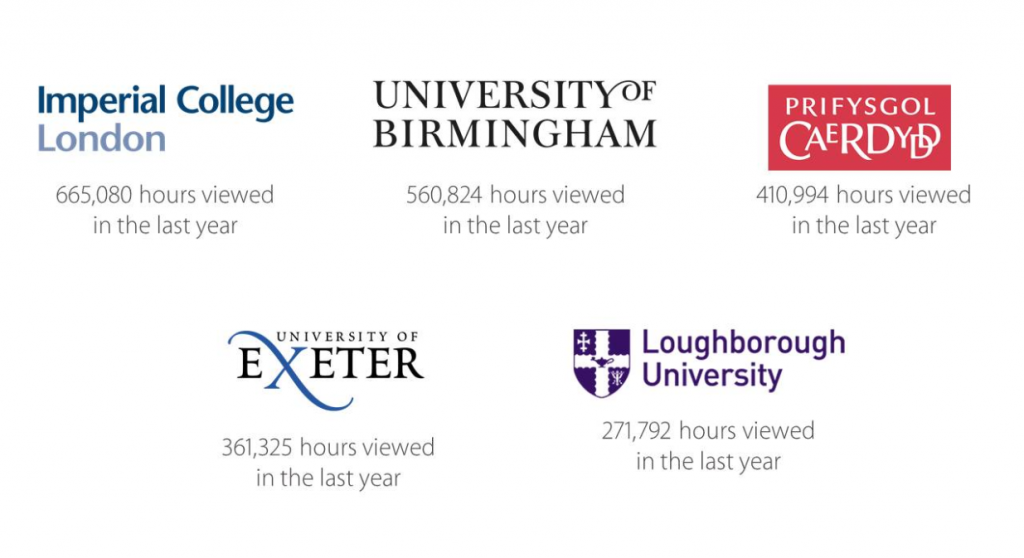
Early concerns about the detrimental effect of lecture capture on students attendance have proved unfounded, with 85% of respondents to a 2019 report stating that the use of lecture capture had ‘No Impact’ on attendance.
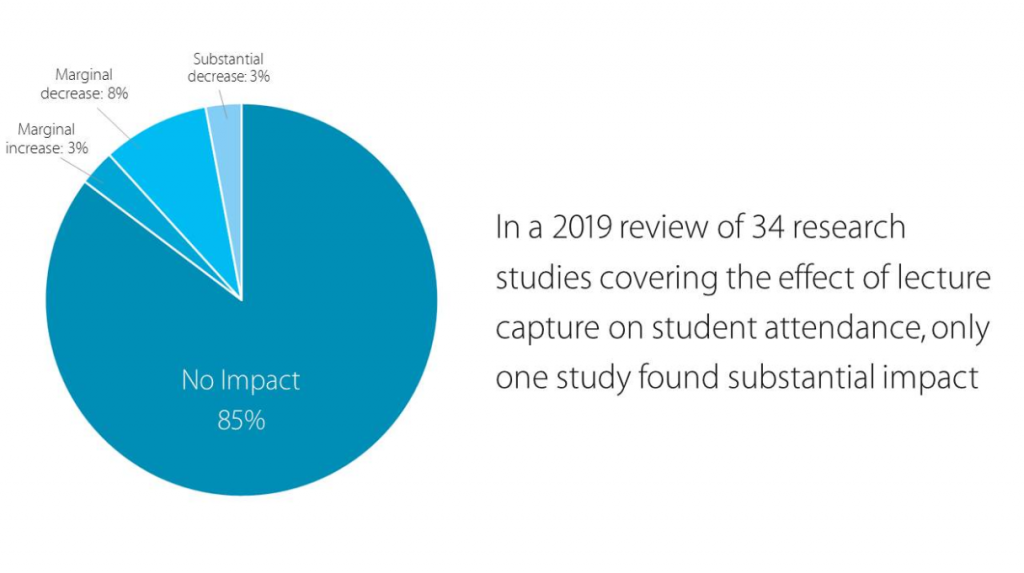
The keynote moved on to focus on students’ opinions on both lecture capture and video content in general, emphasising students’ preference for authentic video content, regardless of production values. The lesson for Higher Education being to focus more on the content of the video and building a rapport with the audience, rather than dense slides, stilted delivery and an information dump approach.
“Students want authentic content, not the facade with lecture capture” – Eric Burns, Panopto CEO
This has lead to the one-take-workflow where content creators turn on the camera and start recording without the need to be concerned about bandwidth, studio time, storage etc… Creators can take multiple takes, cut out whatever they want and choose only their best content. This is possible as video is, for all intent and purposes, free. It’s not something you have to worry about ‘wasting’.
Rise of multi stream
Next, Eric discussed the rise of multi stream recordings which allow multiple participants, screensharing, slides and visualisers, moving on from the single camera setups of earlier lecture capture systems. Multi-streaming has gained prominence in part due to the rise of online meeting tools such as Skype, Microsoft teams etc… where these features have become commonplace. Describing the relationship between technology and pedagogy, Eric emphasised the importance of having pedagogy first in mind when adding new features – ‘if an instruction cannot be captured correctly, the technology subverts rather than supports the pedagogy‘.
Consumerisation of technology
Another contributing factor to Panopto’s success is the increasing consumerisation of technology, in particular the rise in mobile devices, which dwarfy the adoption of desktops in terms by a scale of nearly ten to one.
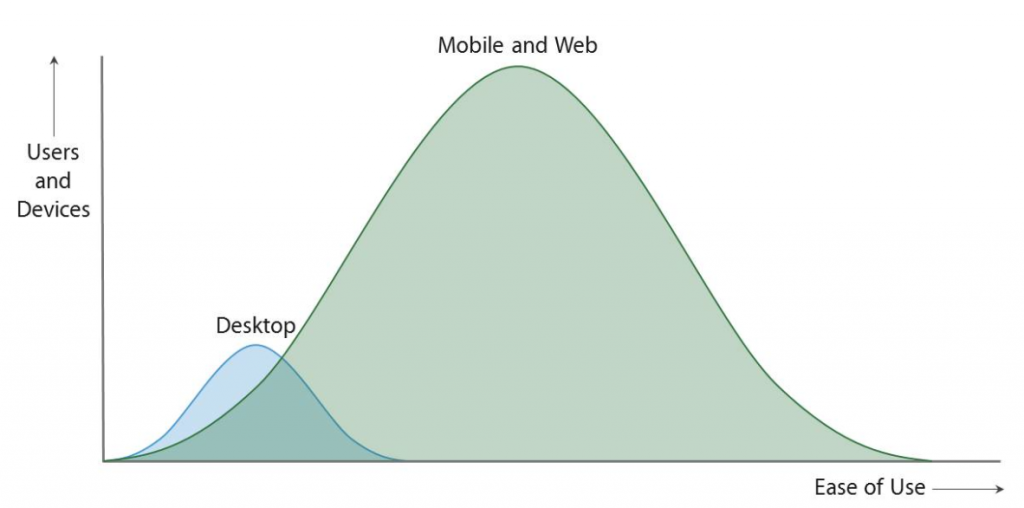
This has resulted in many institutions adopting a policy of BYOD (bring your own device) rather than supplying students with hardware. Mobile devices have given students the ability to access lecture recordings ‘anytime, anywhere’ which has played a major role in the increased acceptance of lecture capture in educational institutions.
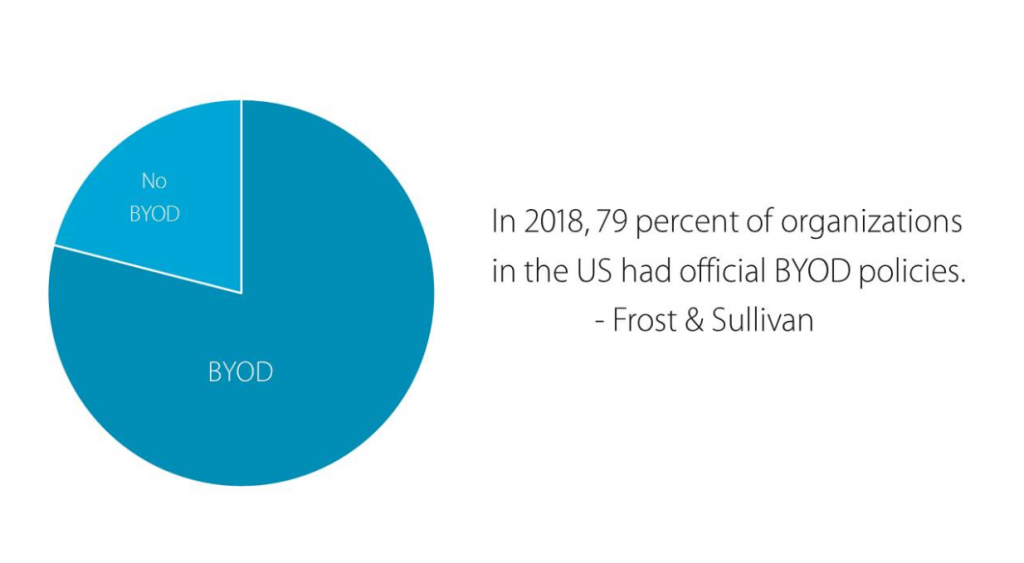
Death of the client
Eric continued with a discussion of trends in the technical administration of lecture capture systems, highlighting a noticeable shift towards HE institutions locking down admin access on individuals PCs, which, in combination with the ubiquity of mobile devices, has resulted in a decline in the use of client applications in favour of web based applications that do not require installation. In tandem with this trend, user interfaces have moved from favouring functional, dense, complex icon-heavy design to a more streamlined user-centered design. Eric used the analogy of water flowing downhill – users will favour designs that offer the path of least resistance.
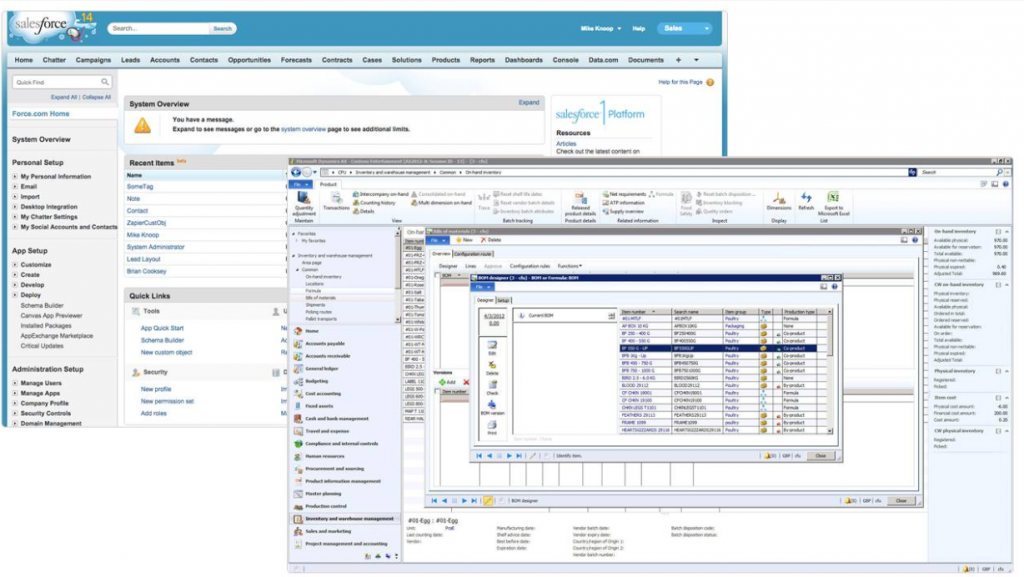
Panopto’s next update
Having discussed the technological and social changes that have driven Panopto in the past, Eric looked to the future in the final segment of the keynote. Whipping the cover off a nearby table in a Steve Jobsian flourish, Eric revealed the next generation Panopto experience underneath – an all-in-one browser-based video capture system which removes the need for client software entirely. The soon to be Beta upgrade allows direct capture from the browser with multi-stream recording (up to 4 streams) plus a “confidence view” showing you what your video looks like. This will unify the experience across web and mobile with a streamlined ‘1-button record’ user interface for both.
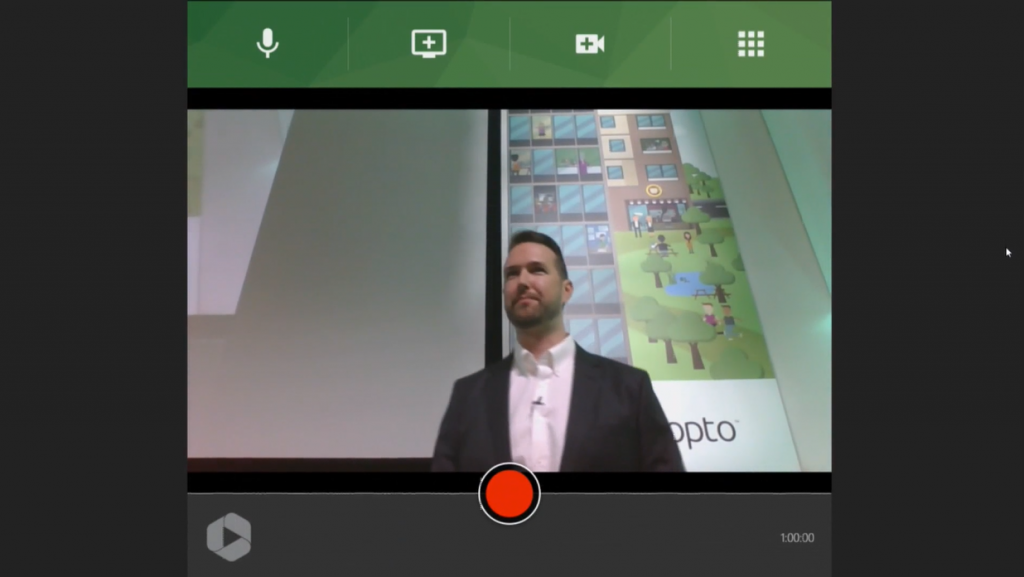
The impact of video on student attendance and results
Presenters:
- Dries Vanacker, Educational Developer, Arteveldehogeschool
- Olaf Spittaels, Educational Developer, Arteveldehogeschool
The presentation started with an overview of their previous generation of LMS, they have now moved towards a new LMS based on canvas that reduces clicks and has customised integrations with other tools.
New technology was brought in to facilitate uptake of the new learning technologies, for example Pixio the robot cameraman!
This resulted in wider uptake of not only use of the LMS but lecture recording too, however there were still concerns from some staff that students would not attend lectures if their lectures were all provided as recordings.
To answer these concerns, they looked at multiple studies and found conflicting results on whether attendance is affected or not so they decided to embark upon a study of their own.
They set out to answer three questions:
Their study ran over two academic years and looked at the same programme, the first year without lecture recording and the second year with lectures recorded. The impact of the recordings was assessed by looking at how much of the recordings the students were watching.
To look at the reasons the students were using the recordings they surveyed the programmes of students they were monitoring:
The attendance of lectures was also monitored, the results below are from the lectures that were recorded however, a similar trend of absenteeism was observed in the previous year of students that did not have lecture recordings available.
To address lecture attendance in general they sought student feedback on why they do or do not choose to attend lectures
The full results from the study were reviewed along with the exam results of the students from both years. An increase in exam performance was observed for the students with access to recorded lectures. The overall data led to the conclusion below:
The study is to be continued with the addition of “bite sized” videos introduced to course content with more interactive elements.
The full presentation is available via http://bit.ly/Panopto_AHS
Closing Morning Keynote: What if Education 4.0 became ‘video-first’?
Professor Gilly Salmon, Online Education Services
‘Education 4.0’ is coming declared Gilly Salmon! And it’s up to us to shape it.
Video learning, with Panopto riding at the forefront, could encounter a similar development trajectory that Gutenberg’s printing press did almost 600 years ago. Where Gutenberg unlocked the accessibility of books and therefore mass education, video could do this again for a modern audience, therefore heralding a new golden age – ‘Education 4.0’
In her fascinating keynote speech, Professor Salmon explained that soon, higher education learning environments are going to experience a seismic shift in order to inspire new generations of digital native learners and to prepare them for the rapidly changing world of work. She went on to explore what ‘Education 4.0’ might look like and the importance of universities to rethink their teaching a learning strategy with a ‘video-first’ mindset. Technology is changing and so teaching and learning techniques must develop with it. An important point to consider, when introducing more video into learning experiences, is that individuals respond and learn in different ways – some binge watch, some don’t for example.
Professor Salmon went on to investigate the future of Work Skills in detail, identifying key drivers, such as global connectivity and increased use of smart machines, that will shape the landscape of skills needed. To meet these challenges Professor Salmon introduced some ‘Education 4.0’ threshold concepts for us to consider, with a focus on bringing the human capabilities to the forefront of learning, utilising skills such as creativity, collaboration, communication and critical thinking.
New features and how they can help your institution
The first technical breakout session was hosted by Meghal Patel, Panopto’s head of product. Meghal gave an overview of the Panopto changes that have been implemented over the past 12 months and gave examples of how these features can enhance the learning experience for students and staff. Details of these improvements are categorised below:
Mobile and embed experiences
Previously, viewers of Panopto content have had less functionality when viewing on mobile or embedded players, compared to viewers using the Panopto web UI. Since June 2019, the options available for the Panopto player when viewing content embedded in a VLE or on a mobile device has been greatly improved, and now includes commenting on videos, participating in quizzes, bookmarking content and taking notes.
OCR improvements
The optical character recognition system which detects the words written on presentation slides has been significantly improved, with better relevance and faster search performance. In addition, the search tool now brings up matched OCR text in context, so the search term is shown along with the rest of the text it appears with. For example, if you search for the word ‘project’, the search tool would find the occurrences of the word ‘project’ in a slide together with some of the preceding, and following text.

Smart Search
In response to community suggestions, Panopto have optimised their search algorithm towards a higher relevancy for fresh content, so newer content appears higher in the results list. The smart search tool now includes support for Swedish, Hungarian, Danish and Norwegian languages.
Personal recorder
The maximum secondary screen resolution on personal recorders has been increased to 1920 x 1080px and 30 fps. In addition, Panopto have added the capability to capture the computer audio for Mac versions of the personal recorder, bringing parity with the windows version. The personal recorder is now compatible with busy light also.
Editor improvements
The pointer and cut tool have been streamlined into one tool, with a single click now representing a seek and a drag representing a cut. In addition, cuts can now be previewed before they are applied. These improvements are aimed at making editing more intuitive and minimizing clutter in the UI.

Quizzes
Fill in the blanks questions are now available. These include live previews so the answers are displayed in the question editor alongside the blanks to be filled in.
Embedding content
A new search interface has been developed which allows videos to be searched for before selecting them for embedding.
Publishing
A new ‘publish now’ button has been introduced to facilitate one click, immediate publishing.
Captioning
Many new Caption providers are now available, such as AI Media. A new option has been added to request captioning for only a small portion of the video, rather than the entire video.
For Administrators
Panopto received feedback from the administrators that managing the large volume of content present on Panopto environments with several years worth of video was a significant challenge. In response to this, Panopto have developed a content retention system, which comes prebuilt with several presents that determine when content should be deleted in relation to the creation date, modification date, availability date or the videos last view. In addition to these presets, custom retention rules can also be created. Content can be placed into the recycle bin, hidden or permanently deleted from the system.
Analytics
Analytic dashboards are now available for Admin, department admin and creator roles.
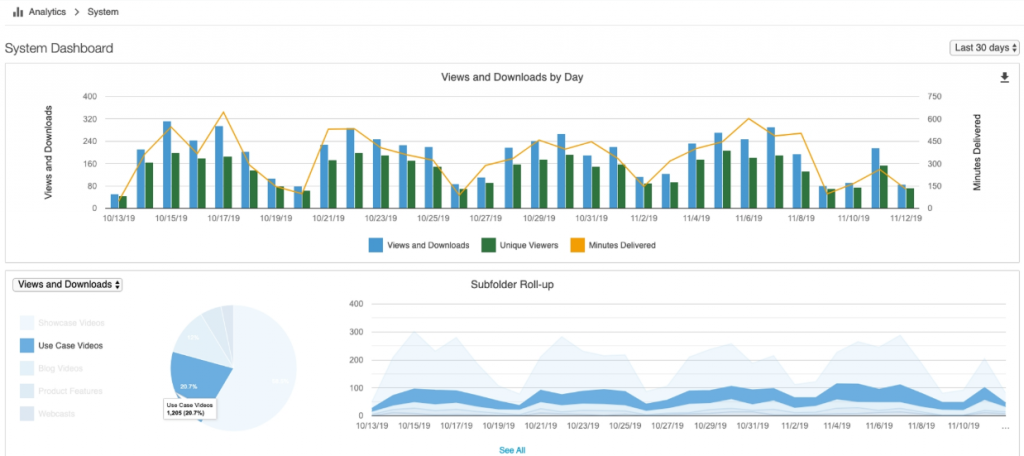
The admin dashboard displays video views over time, details on the folders viewed videos reside in and usage per subfolder.
The video usage dashboard also displays the videos viewed and downloaded by day, together with an engagement chart showing how many people have watched each different video segment, including how many have added comments for each section. This helps admins identify which segments of a video are of the most interest to viewers.
The creator dashboard displays usage for all content the user has created. This data can be drilled down to view videos by users, who has watched it and how much has been watched (in terms of completion percentage). Statistics per user can also be viewed to analyze which users are engaging with the content.
Admin presents
The final set of new features discussed focused on the admin presets for the personal recorder. These can now be set to predefined settings such as video source, audio source and video quality by administrators. These presets can be saved as default, ensuring future users of the personal recorder containing these defaults are using a uniform set of settings.
Teaching and Learning Breakout 1: Beyond Lecture Capture: Part One
In the first teaching breakout session of the Panopto conference in November, Adam Harvey and Andrew Reid from the University of Plymouth gave a presentation on the way they have used Panopto to increase the access to simulation learning. Plymouth originally ran an opt in pilot for Panopto in 2015, and as of 2016/17 they have moved to a campus wide supported system.
What was particularly interesting about the way in which the University of Plymouth was using Panopto to capture learning scenarios that previously couldn’t be done without video. For example, Doctor and Patient consultations were captured, and then streamed via Panopto which allowed for a greater number of students to have access to real life scenarios. Panopto was also used for filming surgeries. Reid explained that as an AV Technician they installed cameras in the ceiling of training rooms, able to capture surgeries from a bird’s eye view, so even for students who were present, they were able to go back to the Panopto recording and see what was going on from a clearer angle.
Harvey and Reid spoke a lot about how Panopto had aided the revolutionisation of simulation learning and has allowed a greater number of students to view simulation exercises, traditionally held in small setting. This has allowed for teaching hours to be maximised and creates a more inclusive environment, offering the same content to all students.
How to improve your use of video using the Panopto API
The second technical breakout session was presented by Josha Chande, (Panopto support manager) and focused on leveraging the capabilities of the Panopto API. After outlining how the API could help institutions customise and support the Panopto experience, Josha gave some specific examples of applications developed using the API. These included:

- Calendar integrations: Using Google calendar to schedule recordings at a particular date and time, with room data pulled from the Panopto API RemoteRecorderManagement service.
- Custom folder hierarchy: When existing LMS systems don’t format the folder hierarchy in the way required by the institution, the API can be used to reorder and reword the hierarchy accordingly – for example, placing the date at the beginning of the folder rather than the end.
- Per course feedback folders: When video feedback needs to be provided to students, the Panopto API can be used to create a folder accessible to only that student for the academic to place their feedback in.
- Drag and drop Panopto video into textbox : For an enhanced user experience, the API can be used to enable drag and dropping Panopto videos directly into a text box. This is achieved using a number of API services, including AccessManager to ensure the user has correct permissions for the video, and SessionManager to embed the video code into the text box.
- Remote recorder folder selector: A drop down that appears on login to a Panopto enabled PC which prompts the user to select which folder their recordings should be stored in. This is achieved by accessing the username and using the Panopto API to assess which folders that user has access to
- Batch scheduling: A number of institutions have developed their own scheduling tools which take input from a text file to generate Panopto schedules. These are similar to the batch tool we have developed at Imperial.
Josha explained that the REST API is under active development and is forecast to achieve parity with the features available in the older SOAP API at some point in the future. However, at present the REST API is not as fully featured as the SOAP API.
The presentation then moved on to discuss the community that has grown up around the API, citing the growing number of integrations hosted on the official Panopto Github repository. Community member Graham Robinson was singled out for his contribution to helping others get to grips with the Panopto API through his blog, which include many useful guides and tutorials on how to get started.
Next, Josha was joined onstage by Richard Goodman, Learning Technology manager at Loughborough University who talked about how his institution scaled up to an automated capture system using the Panopto API. Richard presented Review, Loughborough’s online tool for recording sessions via Panopto and making them available via LEARN, their branded Moodle instance.
The review system automatically schedules Panopto recordings from their CMIS timetabling system – similar to the Celcat / Panopto integration we have developed at Imperial. Sessions can be opted out of recording and/or publishing through the interface and delays can be set for publishing the recording. The automation has been a success and has resulted in a stable, reliable system that is well received by students and staff. Richard emphasized the importance of high quality timetable data and the collaboration of IT services, teaching support and academic practice departments in ensuring successful development.
Panel discussion: The role of video in creating accessible and inclusive learning experiences
The conference was wrapped up with a discussion on one of the current hot topics of Higher Education, accessibility.
The panel were led by Alistair McNaught, a specialist in Accessibility and inclusion and included Rachael Hayes from the ICT Digital Education Team who has been working with the Imperial Disability Advisory Service to pilot Captioned Panopto videos with students.
Alistair started by introducing the topic and highlighting common stumbling blocks of getting tied up with “Pedagogical paralysis” where in trying to work out how to make content accessible to all, nothing gets done while how to provide 100% accessible resources is worked out and “Dangerous dismissiveness” where it is assumed there aren’t many people who would need the resource to be accessible so no changes are made.
He went on to highlight that there are three aspects of accessibility that need to be covered to make reviewing accessibility of materials successful, technical, human and digital competence.
Alistair went on to highlight that we should look to minimise the barriers to using accessible content, not only by providing it, but making sure there is clear signposting of how students can consume accessible features.
After highlighting feedback from students on why they found studying with a disability difficult and how accessible content can help; he put this in to context by highlighting the report from the Office for Students on “Are universities and colleges doing enough for disabled students”
The panel were then introduced and discussed questions that had been submitted by the conference attendees in advance of the conference.
This post was contributed to by: @Nick_Collis, @Rachael_Hayes, @Lee_Greatorex & @Jonathan_Blatchford

